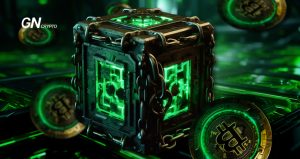How to Replace the Government with a Blockchain?

Blockchain technology, with its inherent decentralization and transparency, seems ideally suited for governance without traditional leadership structures. Can blockchain completely replace traditional government structures? This discussion looks into scenarios where blockchain could be effectively implemented in governance and where it might fall short.
On this page
The concept of replacing government with blockchain might echo themes of communism and social democracy, but how would such a blockchain system operate in reality? How would it manage the distribution of rights among its participants? And is there room for a harmonious coexistence between blockchain technology and traditional government forms? Join us as we ponder over these questions.
The Role of Blockchain in Government
The idea of algocracy, conceived in 1962, revolves around integrating automated control systems and software into government operations, aimed at simplifying city management and logistical processes such as traffic light systems and lighting schedules.
Later on, Chile embarked on the Cybersyn project, an algorithmic system designed to streamline government functions. In 1972, for instance, this system played a crucial role in overcoming a transportation crisis triggered by a massive strike of 40,000 workers, instigated by the CIA to counteract the perceived communist threat in the region.
Cybersyn aimed to extend its control to economic aspects as well, like managing port operations, monitoring cargo specifics, and evaluating port and warehouse capacities. This information was intended to be constantly updated and fed into a central management panel.
Visualization of the intended “Cybersyn” opsroom / Source: Wikipedia.org
From Algocracy to Algorithmic Governance
The concept of algocracy received renewed attention 50 years later in 2009 with Satoshi Nakamoto's publication outlining blockchain's framework for Bitcoin. This milestone prompted academic discussions about the workings of algorithmic governance. These deliberations spanned various models, from fully autonomous systems to those that are partially or collaboratively controlled.
Blockchain's Utility in Establishing a Trustless Environment
While most technical solutions can technically be replicated without blockchain, for instance using MySQL with appropriate data filters and permission settings, blockchain's unique appeal lies in its censorship-resistant nature. It's an environment where data changes or falsifications are virtually impossible, ensuring complete transparency and fostering trust in the system, even among participants who don't personally know each other.
More private iterations, such as non-public private chains, retain this resistance to censorship. They safeguard crucial information through anonymization, which can later be decrypted and accessed on compatible devices.
Blockchain's Integration into Government Functions
In 2017, the Ukrainian government, in collaboration with Bitfury, considered adopting blockchain to enhance transparency in its tender procurement processes. Similar blockchain initiatives are being explored and implemented in various countries. In 2024, there are 11 fully operational Central Bank Digital Currencies (CBDCs), with an additional 33 in development and 46 in the research phase. Canadian police and legal professionals undergo training with Chainalysis Reactor, and information sourced from Reactor is being incorporated into legal proceedings related to cryptocurrency fraud. Even in traditionally corruption-prone voting, blockchain's potential is being tapped, as evidenced by Australia's consideration and eventual implementation of blockchain-based voting systems. This process began as early as 2016.
For most people, government systems remain opaque and complex. They appear straightforward until one seeks a permit or aims to accomplish something. The activities of politicians are elusive to the masses. People, relying on media that craft the political narrative, find themselves trapped in an external information bubble. The scenario has grown so peculiar that targeted ads now promote apps ranking media outlets by political bias, while the popularity of courses in information hygiene is surging.
The concept of merging blockchain with algocracy's fundamentals revolves around the synergy between smart city infrastructure, IoT technologies, and a decentralized governance system. Elements amenable to risk-free automation are embedded within smart contracts operating in the blockchain's virtual realm.
Applications of Blockchain in Urban Life
This includes managing network loads, banking, and documenting the reputations of urban landmarks. Dr. Samuel Ariaratnam at Arizona State University suggests that blockchain can be instrumental in smart city governance. The model is clear and straightforward: city operational data are maintained and organized in a blockchain, featuring self-executing smart contracts. This bidirectional connectivity paves the way for integrating executive, legislative, and administrative system components based on algorithms.
Blockchain in Smart City Infrastructure | Source: www.mdpi.com
Instances of Algocratic Elements in Use
In the USA, there are 77 instances involving entities like the Justice Department, SEC, NASA, the FDA, and the US Patent Office. For instance, the New Orleans Police in 2012 collaborated with the Palantir project for predictive policing, reminiscent of “Total Recall” and “Psycho-Pass.” Since 1995, FinCEN has been utilizing FAIS, an AI-based system, to thwart money laundering. The US Department of Homeland Security employs the ATLAS system to analyze all “assimilated” Americans, ultimately to decide on their denaturalization or, in simpler terms, deportation.
Why Governments and Oligarchies Might Find Blockchain Unfavorable
The concept of “democracy” traditionally signifies the rule of the people. However, in ancient Greece, the term “people” referred to wealthy patricians owning land and slaves. Slaves lacked the right to vote or defend their honor against a patrician, with any dissent potentially leading to harsh punishment or even death by whipping.
Algorithmic legal verdicts are not a novel concept. In Australia, the AI system Split Up supports judicial decisions in divorce settlements. The United States uses COMPAS for assessing recidivism risks in courtrooms. Estonia aims to employ AI for resolving legal disputes up to 7,000 Euros, and China has advanced further with an AI judge aiding in routine tasks like document verification.
Blockchain, in its purest form, epitomizes radical democracy: total decentralization, anonymity, and the removal of social statuses that lend ‘authority' to individuals. It's intriguing to consider: that smart contracts in blockchain networks enable the burning and reissuing of tokens in a different location without trusting any party. Similarly, this principle could be applied to the tokenization of an individual's political will.
- Total Oversight of Politicians. Implementing blockchain for its intended purpose would entail automated, all-encompassing surveillance of every move made by officials at all levels. An activity dashboard for politicians could be integrated into e-government applications like “Diia.”
- Immediate Accountability. Blockchain's unalterable nature means that data verification and decision-making can be done through smart contract invocation, relying on discrepancies found when comparing two sets of data. Certain legal processes might proceed automatically if the blockchain contains adequate information.
- Radical Transparency. Due to blockchain's immutable nature, people can observe and record politicians' actions in real-time. Addressing unlawful legislation wouldn't require physical protests; dissent could be expressed directly from a smartphone.
- Independent Systems. A smart contract's code is impervious to persuasion or corruption. Participants of such a blockchain network could store this code within existing governmental e-applications on their smartphones or as part of a specialized wallet. Acting as a neutral “third party” or “mediator,” an algocratic blockchain would be independent of any single individual's decisions.
- Collective Responsibility. Once voting results are entered into a blockchain, they become tamper-proof, empowering everyone to directly influence governmental operations.
An algorithmic state represents a theoretically ideal application of blockchain. With its decentralized structure, distribution of rights, and real-time updates, this system can bridge public trust and official duties. Process transparency would discourage self-serving behaviors and promote collective action – gaining trust through tangible actions becomes easier.
However, blockchain is not a panacea. While it is adept at storing data that can enhance the process of law-making and decision-making, risk assessment remains a human responsibility. Blockchain's role in this ecosystem is to deter deception, political blackmail, and power brokering. On the human side, opposing blockchain-sourced information without solid reasons could warrant consequences.
Diagram of Interactions Between Government, Blockchain, and Society / Source: MDPI.com/ GNcrypto
Is There Currently a Foundation for Such Technology?
DAOs, or Decentralized Autonomous Organizations, Оare not designed for profit generation but can be invaluable for managing finances, orchestrating voting, and handling documents through blockchain and smart contracts. These organizations are geared towards collective governance. A challenge is the time investment required for participant education, given the processes' complexity and novelty.
Integrating DAOs with governmental functions wouldn’t necessitate extensive retraining: activities like voting, elections, legislative processes, obtaining certifications, and data registration are already part of adult life. This indicates that the DAO framework is essentially in place; it merely needs the addition of automation and detachment from government control.
How Can We Track Official Actions in Real-Time?
This could be accomplished through video surveillance and content analysis. Deploying neural networks trained on officials' behavior patterns could automate the integration of this data into the blockchain. Facial recognition by neural networks, a feature already present in commercial offerings from Google, Open AI, Microsoft, and Apple, is not new. China's use of neural networks for public surveillance—where video recognition is used to issue targeted traffic fines almost instantly and with minimal error—is a testament to this technology's capabilities.
What Components Would Be Necessary for This Implementation?
This setup should be approached as BAAP – Blockchain as a Platform, where blockchain merely serves as the foundation for government-executing algorithms. Utilizing IoT technologies and smart city infrastructures would enable the automation of executive and legislative functions via smart contracts. The synergy between IoT sensors and blockchain validators could continuously refresh the blockchain with up-to-date information on governmental operations at all levels.
To realize an algocratic blockchain, the following components are essential:
- IoT integration for real-time urban data gathering;
- Tokenization of will, creating two tokens that represent a person's political stance: consent and dissent;
- Adapting laws to function as smart contracts within the blockchain;
- Implementing decision-support technologies such as AI assistants that can handle sensitive information confidentially;
- Designing, developing, or adapting a dedicated state network for the exclusive operation of this system, ideally decentralized to be distributed across numerous devices;
- Crafting blockchain software architecture to facilitate enforcement, validation, negation, acceptance, and contestation of decisions.
This approach would pave the way for a network of genuine blockchains. Bridging technology would enable the integration of existing offline chains, which are part of managing supply chains in agriculture, heavy industry, and production. The next phase could involve connecting commercial blockchains used for applications like coffee supply chains, targeted charity fund allocation, and postal tracking systems.
How Would This Blockchain Operate?
A key feature would be the public's veto power. Any proposal, draft law, or document would enter a queue for amendments or changes within the blockchain and its embedded laws, akin to the processes in Ethereum, Polkadot, and Tezos, where member consent is needed for modifications. However, some proposals are easier to reject than endorse. Therefore, a mechanism requiring 65% of public dissent is established to veto a bill. Typically, if this level of disagreement isn’t met, the bill moves forward for further review, revision, and approval. An alternative is setting a threshold of 65% combined agreement from both conservative and liberal citizens.
Consensus Achievement Example Between Society and Politicians in Decision-Making | Source: MDPI.com/GNcrypto
The system would continuously update the level of public agreement or disagreement in real-time. Society’s opposition to particular bills would be reflected in the reputational scores of individual politicians and political factions. Attempts to amend existing articles or to rewrite older laws could also be tracked separately. Preserving the interdependence of legal articles would prevent overly radical changes.
Possible Scenarios for Implementing an Algocratic Blockchain:
- Blockchain acts as a tool for monitoring politicians, enforcing their accountability, and motivating them. The final decision rests with the public: blockchain, along with IoT, gathers and delivers data for analysis and auditing. Disputes are resolved by reaching a consensus between the involved parties.
- Routine decisions rest with smart contracts. People focus on more critical aspects, avoiding political mundanity in managing, formatting, transferring, and validating documents. Bills are drafted transparently, based on a collective “disagreement” with their content, necessitating further refinement.
- Algorithms handle all but crucial decisions. This includes managing benefits, pension funds, etc. For any legislative changes to be adopted, 65% of the participant consensus is required to agree.
Let’s consider a scenario where blockchain serves as a mediator between the state and society. It becomes an independent third party, balancing political decisions against public reactions. The blockchain records metrics to evaluate the benefits of new laws and amendments. Optionally, if a law reaches a high level of “inefficiency,” the algorithm might request its amendment or refinement. Neither society nor government holds complete control over the blockchain; changes are made collectively.
Blockchain as a Mediator Offers a Balanced Approach:
- Veto based on collective disagreement with proposed laws or decisions;
- Gathering and organizing pre-election data about politicians, including their positive and negative actions, decision history, and the reputation of their decisions or proposed bills;
- Collecting and organizing data on politicians’ work: attendance, public speeches, their alignment with actual activities, and tracking political promises based on blockchain-anchored KPIs;
- Developing a system for reputation management and monitoring politicians' fulfilled promises.
This balanced approach aims to prevent the concentration of power in a single entity. The ultimate development of this technology might lead to the creation of a “political” social network, where actions directly influence government operations. Employing a gamified approach could facilitate the swift adoption and integration of this technology. However, platforms like Facebook would not be suitable for this purpose.
The content on The Coinomist is for informational purposes only and should not be interpreted as financial advice. While we strive to provide accurate and up-to-date information, we do not guarantee the accuracy, completeness, or reliability of any content. Neither we accept liability for any errors or omissions in the information provided or for any financial losses incurred as a result of relying on this information. Actions based on this content are at your own risk. Always do your own research and consult a professional. See our Terms, Privacy Policy, and Disclaimers for more details.





























